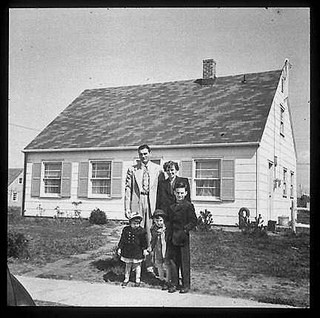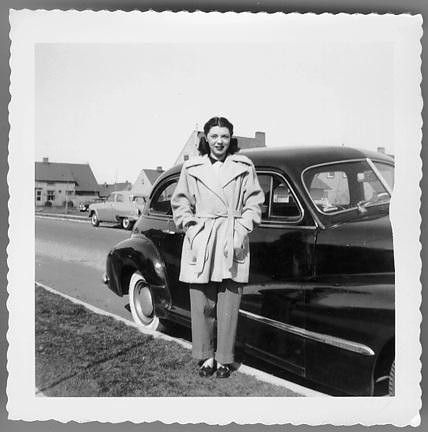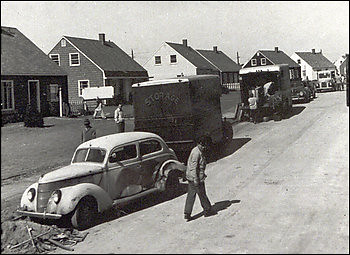Long Island, New York and suburban revitalization more generally
 Levittownhouse, 1948. Long Island, New York, comprised of Nassau and Suffolk Counties, benefitted from outmigration from New York City to the suburbs and is the location of the first major postwar subdivision community, Levittown.
Levittownhouse, 1948. Long Island, New York, comprised of Nassau and Suffolk Counties, benefitted from outmigration from New York City to the suburbs and is the location of the first major postwar subdivision community, Levittown.The title of the blog is "Rebuilding Place in the Urban Space," and while I write a fair amount about metropolitan areas, I focus on center cities. That being said I write from time to time about rural issues--how sprawl affects land use etc., and list a bunch of "rural" resources in the right sidebar, because the field of community development has in large part derived from the profession of rural development and agricultural extension--improving farm yields and communities.
Similarly, suburbs and suburban counties are complex places with interesting issues of their own, with a complex relationship to cities, the core of a region, race, and land use.
The First Suburbs Consortium in suburban Cleveland is an interesting organization, focused on revitalization of inner ring suburbs.
Cities like Philadelphia are actually "city-counties" and counties like Arlington County, Virginia are more like a city. The land use intensification initiatives in the metropolitan area in Montgomery County (the Growth plan, transit orientation, redevelopment of White Flint) and Fairfax County (Silver Line transit, redevelopment of Tysons into a walkable community, the Mosaic development at Merrifield) are illustrations too that revitalization and land use issues of all sorts are important to pay attention to and consider.
Really then, what this blog is about is community revitalization of all types, and while I will continue to focus on center city revitalization, I do need to separate out suburban revitalization resources as a separate category on the right sidebar.
Rebooting the Suburban American Dream
What spurs this entry is that I got an email from the Long Island organization Build a Better Burb," and I had already been meaning to write about Long Island, the suburbs abutting the New York City borough of Queens, because of the recent announcement that the New York Islanders hockey team will be moving to the new Barclays Arena in Brooklyn, and how this is a kind of indicator of suburban decline--the hockey team wants a new arena and the budget-beleagured Nassau County Government couldn't provide it (see the AP story "Long Island voters reject $400M plan for arena").

Long Island, the location of the first large post-war subdivision community, Levittown, built by William Levitt, is probably a good place for reassessment to start.
The Build a Better Burb initiative is a recognition that the Suburban American Dream needs to be rebooted for the 21st Century, that an aging population, if not replaced, means continued decline, and that younger demographics are looking for different kinds of housing and living experiences, and to be competitive for those potential residents the right kinds of places need to be provided (this is at the heart of the creation of places like Bethesda Row in Bethesda or the Mosaic District in Fairfax County) to capture those residents who want an "urban" experience without necessarily having to live in the center city.
And it is a response to the fact that New York City, Manhattan of course but Brooklyn and Queens as well, is on the rise and more successfully capturing residents than is Long Island.
Note also that the "suburban retrofitting" initiative of New Urbanism is focused on this problem as well.
-- Review of the book Retrofitting Suburbia, Urbanophile blog
-- "The New Look of the American Suburb," Urbanophile blog
-- Revitalizing Distressed Older Suburbs, What Works Collaborative
-- The Next Frontier: Retrofitting Suburban Commercial Strips, Local Government Commission
-- "The Quest to Confront Suburban Decline: Political Realities and Lessons," Thomas J. Vicino, Urban Affairs Review, 43:4 (2008)
-- Reinventing Suburban Business Districts, Urban Land Institute
-- Reinventing America's Suburban Strips, Urban Land Institute
-- (and I have written plenty about these issues, in particular about White Flint and Tysons, such as "Short term vs. long term thinking: transit, the Washington Examiner, Fairfax/Loudoun Counties vs. DC")
From email:
- A growing economy that nurtures innovation
- Vibrant communities and downtowns, offering affordable places to live
- An improved regional transportation network
- Quality affordable health care for all Long Islanders
- Educational readiness for all students at every age
- Improved air and water quality, open space preservation, and natural resource conservation
- Fiscally responsible government that provides quality services
When building a community, people tend to think of homes, parks, businesses and schools as that community’s core. What makes a community is the people – the citizens of a town or village that we wave to on the way to the store, nod our heads to when watering our lawns or give a friendly smile when leaving the supermarket.
But the "Build a Better Burb" initiative can also be thought of as a branding and positioning method, but also a campaign, to begin the process of getting people to grapple with change, accept that conditions are changing, and rather than lament, respond to change and remain community relevance in the context of the metropolitan residential and commercial landscape.
After all, the revitalization initiatives they promote--Main Street revitalization, transit, transit oriented development--are all "natural" urban design products already present within the center city.
Labels: car culture and automobility, suburban revitalization, transit and economic development, transportation planning, urban design/placemaking, urban revitalization, urban vs. suburban





0 Comments:
Post a Comment
<< Home